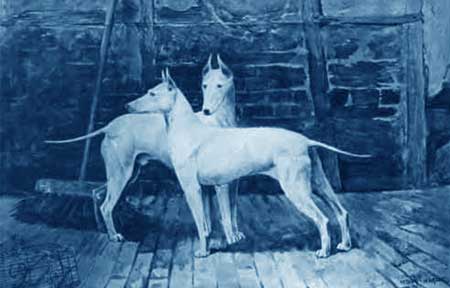The English White Terrier, now extinct, was at the height of its popularity in the larger towns of England from around the 1840s through the 1870s.
This was a time when not incidentally the fad for "improving" dog breeds for show purposes was spiralling out of control. "Improvement" meant physical appearance rather than health, and new breeds were being manufactured willynilly, while old breeds transmuted and blended in that misguided quest for "improvement" directly responsible for a breed's extinction.
Much the same thing is happening with "show standard" chihuahuas today. The show qualifications are all for curl of tail, roundness of head, and especially size. A chihuahua who weighs more than eight pounds is automatically disqualified, in the demand, identical to that for the English White Terrier, for smallness of size.
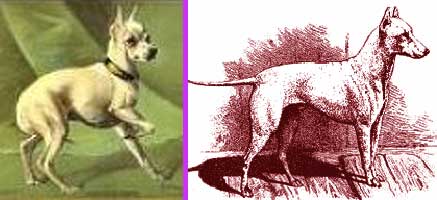
Chihuahuas in the five pound range are so admired which encourages breeders to impregnate small award-winning bitches who'll have to deliver by cesarian. Now while such tiny dogs of good health are possible, what is inevitable is a percentage that will remain in breeding lines that have molera that never close up at all, which have such thin weak legs that hopping off a couch can result in broken limbs or at least knee injuries, dogs for whom children are a danger, dogs which are yappy, difficult to housebreak, and bad-tempered, which are prone to heart and renal imperfections and illnesses resulting in early death, and many other health issues.
Chihuahuas over seven pounds -- and the eight to ten pound range would be the healthy standard -- are such sturdy little critters that they can rough-house with children and larger dogs, leap without injury, molera close up before their third month of life, do not have heart murmurs or worse, not apt to have the buggy eyes and resultant eye-troubles of tinier chis, do not to such a high extent have the neurological condition of constant shivering, and are frankly the better dogs if a good healthy pet rather than a fragile decoration is desired.
So nothing has been learned since those Victorian questers after "perfection" destroyed the health and reliability of the English White Terrier and its close relative, also extinct, the Toy Bull Terrier. Indeed, I drew these parallels for a woman who adores chihuahuas, knows a great deal about them, and has an international reputation for tinier specimens, and she told me in no uncertain terms, "I won't argue with you about this, but you're wrong in just so many ways."
The inability to even weigh the possibility that facts are facts afflicts the "show standard" breeding community and AKC regulations, and when they finally recognized the weakening of the breed in the last couple of decades, they blamed it on merle fur coloring and banned that, though the medical stats for three genetic markers of merle/brindle coats show either zero percent increase in hearing loss for one marker, and an increase no greater than for merles of other breeds (in the 2% range) for the other two genetic causes. The fact is of any ten stone-deaf little chihuahuas, the chances of any of them being merles is fairly slight, but that's as far as the purblind community of show-dog breeders and official organizations will take it.
This discussion is apropos of the English White Terrier because some of the flaws that entered the chihuahua breed began in Victorian times, before the breed had official recognition, and it was being used in outcrosses with the English White and white Toy Bull seeking purer whites and smaller sizes. The English White was noted for molera that would not close up, and such fragility that they had to be protected as house pets lest they hurt themselves in normal play. This was not formerly ever true of chihuahuas, but rather than the outcrossings lending greater stamina to the English White, the English White (and Toy Bull) may well have lent fragility to chihuahua lineages.
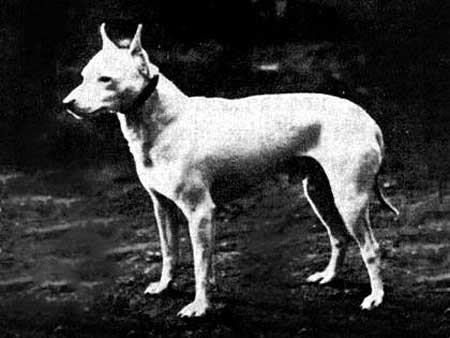
The origin of the English White is lost in obscurity, but it was acknowledged as the most fragile of the terriers, the least useful as a working dog (most terriers were ratters or even flushed foxes from their holes). The English White was notably a bold and fierce little rascal but not sturdy enough for hard work. So it was most commonly a lap dog for women, and a bar-dog for drunkards who wanted a little pal to show off in the pubs. They were the "purse dogs" of their day.
Although the origin of the English White is not known, it's believed to have been developed from the fox terrier crossed with Italian greyhound and with the Toy Bull Terrier. There is some question about whether the Toy Bull and the English White were justifiably distinct breeds, both having the same tiny size, molera issues, and bred for pure white fur. Both varieties were prone to deafness due to a recessive gene connected to the purest white furs, and after a period of extreme popularity both were allowed to die out, all specimens by the 1890s reportedy "unfortunate" in health and stamina.
Records of important dog shows in and near London in the 1860s reveal that for a while, three distinct sizes of the English White were recognized, including a category under six pounds weight, with the "large" standard being no more than 14 pounds, and an intermediate "miniature." This division into three sizes was later reversed, for like the modern chihuahua, dogs of differing sizes could arise even from a single litter.
The first imported chihuahuas were not so small as the smallest English Whites or the smallest Toy Bulls. Chis were rendered smaller when outcrossed. The English White originally had a long "deer" head but, and the Toy Bull initially a broad head, but both had a tendency to produce what we today call "applehead" in chihuahuas, with associated and signal health concerns for those with round heads. They are probably the origin of the modern applehead chihuahua, which is long predated by the deerhead chihuahua.
By century's end English White and Toy Bull terriers were dying out, and the original deerhead chihuahua had developed "preferred" (as show dogs) appleheads whose skulls' molera were extremely slow to close up, as had been the case with the smallest roundest-headed Toy Bulls and the English Whites. Further outcrossing was done between chihuahua and the English Toy Terrier from which the tri-point Manchester terrier arose, always in the quest for smallness and with the hope of doing away with fragility.
The Manchester was developed from the Black-and-Tan Terrier, aka English Toy Terrier. A Victorian portrait of three dogs reproduced in-text shows an English White and English Black-and-Tan side by side, and a smaller black-and-tan seated on furniture. The smaller is not a pup; the black-and-tan, like the pure English White, had no clearly standardized size other than small, smaller, and smallest.
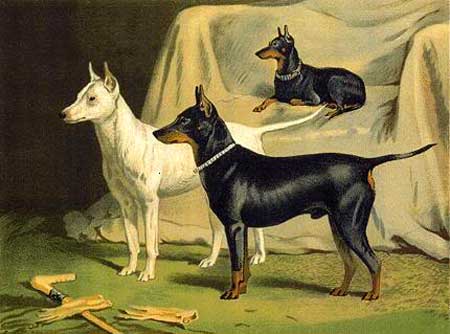
The health issues, including deafness, were associated with the white coloring, so the tri-point or black-and-tan terriers survive to this day and tend to be healthy dogs. But selection for pure white fur lacking even the occasional dark markings (which existed in every litter) meant an increasing percentage of the pure white terriers were hard of hearing or deaf as stones.
Even people who didn't mind a fragile lapdog didn't want a deaf one, and at last the breed were permitted to die out for loss of popularity. And yet some of the issues remain with us in the chihuahua and the continuing incidental malice of breeders who'll swear up and down they breed for health but really breed for size and shape.
The ideal English White Terrier was supposed to have a long and narrow head with flat top. The tendency in the breed to produce thicker rounder skulls disqualified them as show-class, due to the open molera associated with rounder heads.
The smallest English Whites apparently were most prone to round heads, and a Victorian color painting of a specimen, depicted with a couple coins to give a sense of size (and reproduced below), has the rounder head, lacks the sleeker body, and looks awfully much like an overweight chihuahua (except for its ears which, illegally, have been clipped).
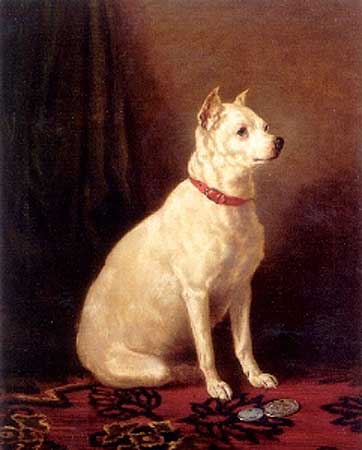


|
